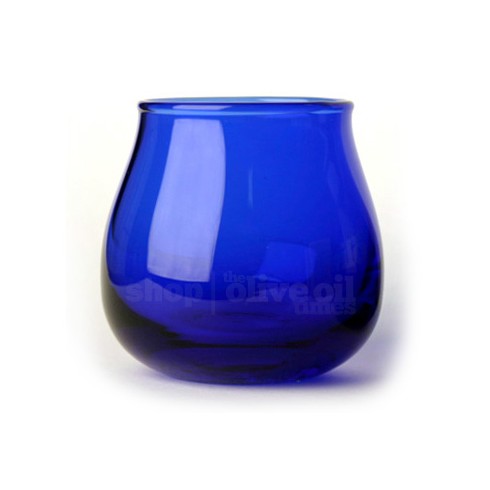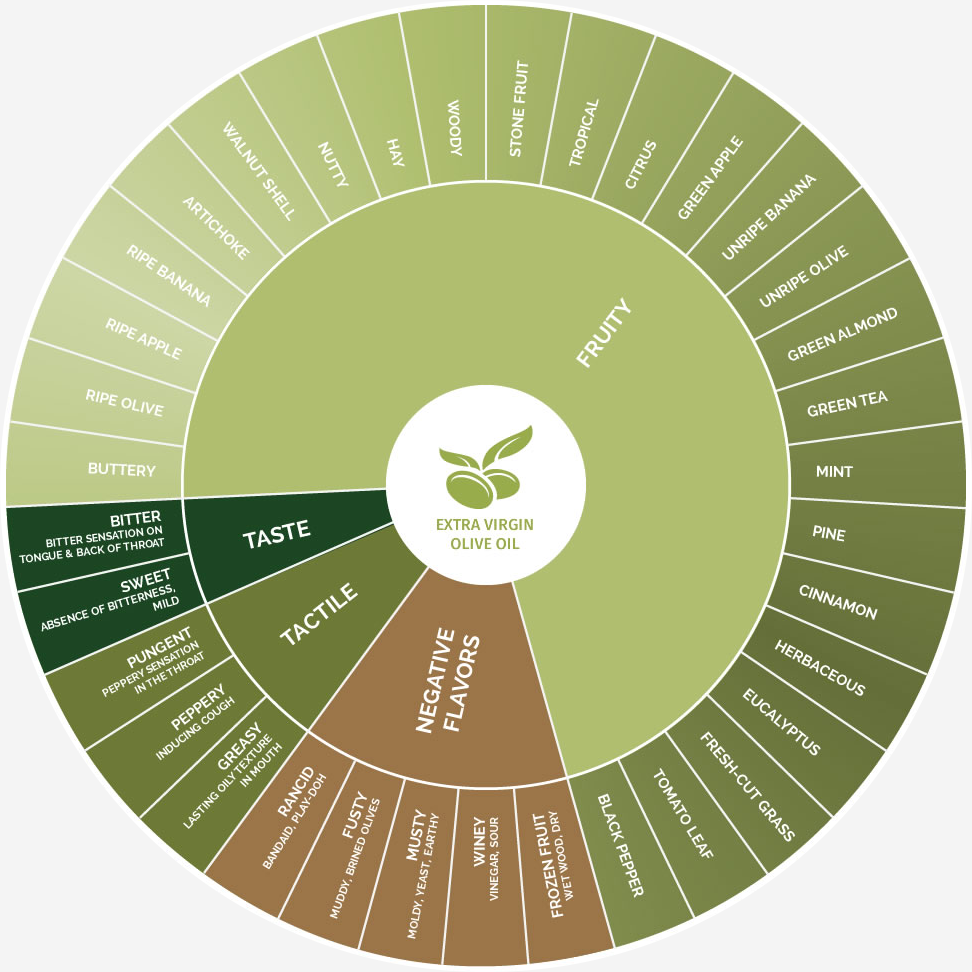Olive oil has a specific way that it should be tasted to get the full effect of the oil -- just like you would taste wine. I do a lot of olive oil tastings in meetings with customers, along with training our staff internally.
Here's a quick run down if you've never officially been taught how to taste olive oil.
First, Use The Right Tasting Glass
The official choice of International Olive Council tasters (or anyone judging olive oil) is small, tulip-shaped blue glasses.

This is because the blue glass hides the color of the oil inside, allowing you to do truly blind tastings. The goal is to avoid any visual biases you may have. For example, if you see a very green olive oil, your brain may associate the color green with good oil, and affect your unbiased judging abilities.
Everyone in the olive oil industry agrees -- color doesn't mean anything when it comes to olive oil. Light colored Extra Virgin Olive Oils can have the most pungent flavors, and a dark green oil can still be very mild or of poor quality. They're two totally unrelated traits.
If you're just doing an informal tasting, we understand if you decide to skip the blue glasses -- just try not to judge the oil based off the color.
Warm Up The Oil
A key part of releasing the aroma and flavor of the oil into the air is to warm it up.
Pour about 1-2 tablespoons of oil into your glass. Then cup one hand under (which will heat the oil from below using the warmth of your hand) and one hand over (to capture any smells inside the glass).
Swirl it around a few times to release the smells into the air trapped inside your cupped hands.
Smell
Bring the glass to your nose, remove your hand and smell the oil deeply. Take note of the aromas you're sensing. Look for adjectives like green, ripe, earthy, fruity, or nutty. Or perhaps, you'll be able to smell some of the exact flavors in the infographic below. Take note of them before you begin tasting.
Smelling the oil, just like you would with wine, is part of what allows you to fully taste it in the next step.
Slurp / Strippagio
Take a small sip of your olive oil (about 1/2 to 1 teaspoon is plenty, don't overdo it). Coat the inside of your mouth and let the flavors cover your tongue by relaxing your mouth. Allow it to sit in your mouth for a moment to fully coat.
Next, suck in some air. Touch your tongue to the back of your top teeth and inhale. I like pretend that I have straws in my mouth like walrus teeth, and that I'm using them to suck in air. Other folks sharply inhale air through their teeth, which sprays the oil that has just coated your tongue around your mouth, and allows air to enter your throat which brings out more of the flavor.
This method of sucking in air through your teeth for tasting olive oil is called strippagio, and everyone has their own flair.
Close your mouth with the oil still inside and breath out. As the air moves through the olive oil in your mouth, it picks up aromas and brings them up behind the back of your mouth, into your nasal passages.
Usually before swallowing, I do this process a few times -- breathing in using strippagio, trying to note any flavors, and breathing out with my mouth closed.
Swallow
Lastly, you will want to swallow some of the oil to get the full flavor notes. Some flavors are only tasted on the back of the tongue, so this is where you will taste some of the pungency of the oil.
If you are tasting a peppery oil, it's common in this stage that the oil will make you involuntarily cough -- some growers say that if it doesn't make you cough, it's not truly good oil! That's not really true, however, it all just comes down to personal preference on flavor.
Note The Flavors You Taste
Lastly, make notes of the flavors that you smell and taste throughout this process. Look for adjectives like the following:
Apple/Green Apple: indicative of certain olive varietals
Almond: nutty (fresh not oxidized)
Artichoke: green flavor
Astringent: puckering sensation in mouth created by tannins; often associated with bitter, robust oils
Banana: ripe and unripe banana fruit
Bitter: considered a positive attribute because it is indicative of fresh olive fruit
Buttery: creamy, smooth sensation on palate
Eucalyptus: aroma of specific olive varietals
Floral: perfume/aroma of flowers
Forest: fresh aroma reminiscent of forest floor, NOT dirty
Fresh: good aroma, fruity, not oxidized
Fruity: refers to the aroma of fresh olive fruit, which is perceived through the nostrils and retro-nasally when the oil is in one’s mouth.
Grass: the aroma of fresh-cut (mowed) grass
Green/Greenly: aroma/flavor of unripe olives
Green Tea: characteristic of some unripe olive varieties
Harmonious: balance among the oil’s characteristics with none overpowering the others
Hay/Straw: dried grass flavor
Herbaceous: unripe olive fruit reminiscent of fresh green herbs
Melon: indicative of certain olive varietals
Mint: indicative of certain olive varietals
Pear: indicative of certain olive varietals
Peach: indicative of certain olive varietals
Peppery: stinging sensation in the throat which can force a cough (see pungent)
Pungent: stinging sensation in the throat which can force a cough (see peppery)
Ripely: aroma/flavor of ripe olive fruit
Round/Rotund: a balanced, mouth-filling sensation of harmonious flavors
Spice: aroma/flavor of seasonings such as cinnamon, allspice (but not herbs or pepper)
Sweet: characteristic of mild oils
Tomato/Tomato Leaf: indicative of certain olive varietals
Tropical: indicative of ripe olive fruit with nuances of melon, mango, and coconut
Walnut/Walnut Shell: nutty (fresh not oxidized)
Wheatgrass: strong flavor of some green olive fruit
Woody: indicative of olive varietals with large pits
This infographic is also helpful as you're looking for adjectives to describe the oils.

More Resources
If you want more information, here's a good explanatory PDF from the North American Olive Oil Association. They also have a good video explaining the process.
And California Olive Ranch also has a good information here.
Topics: Industry Trends, Quality Control












